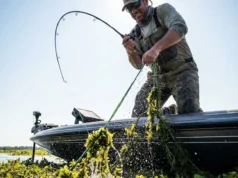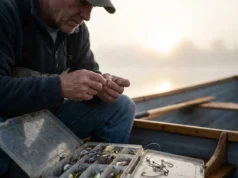In this article
The wind cuts across the bow, bowing your fishing line and dragging your bait aimlessly across the bottom. Beneath the surface, your lead sinker acts like a shock absorber, dulling the crucial “tick” of a bite into a muddy nothingness. In precision angling, the fishing weight at the end of your line is not just ballast; it is your primary source of underwater intelligence. Treating this critical piece of terminal tackle as an afterthought is the fastest way to miss the fish of a lifetime.
I’ve spent decades staring at sonar screens and dragging lures over everything from razor-sharp zebra mussel beds to endless flats of eelgrass. I’ve learned that “dead weight” kills sensitivity. When you upgrade from generic lead weights to specialized precision tools, you stop guessing and start visualizing the structure. This buyer’s guide moves beyond the basics of split shot, taking you through the physics of density, the necessity of specific geometries for different fishing conditions, and the specialized loadouts that solve the problems of snagging and bite detection.
How to Choose the Right Fishing Weight
To make a smart choice, you have to ignore the bulk bins at the tackle shop and look at the material science. The right weight does two things: it presents your soft plastic lures naturally and transmits sensory feedback back to your hands.
Why Does Material Density & Acoustic Impedance Matter?
Material density dictates the clarity of the signal you receive from the bottom. High-density materials, specifically Tungsten (~18 g/cm³), are significantly harder than lead. When tungsten strikes a rocky bottom or a submerged log, it creates an elastic collision. This transmits a sharp, electric “click” up the line—a concept often referred to as “neuro-feedback.” Lead, being soft and malleable, absorbs that energy, resulting in a dull “thud” that feels identical to mud or clay.
Understanding this difference is critical when deciding where to spend your money. For passive bait fishing using bank sinkers or egg sinkers (sliding sinkers), lead or steel is sufficient. However, for active bottom-contact techniques like the Texas rig or football jigs, the premium price of tungsten is non-negotiable. Experts at Bass Pro Shops generally agree that the hardness of tungsten provides a distinct advantage in deciphering bottom composition.
Beyond sensitivity, density affects profile size. A tungsten weight is physically smaller than a lead weight of the same mass. This reduced footprint allows your rig to slip through dense heavy cover, mats, and milfoil where bulky lead would hang up. To truly capitalize on this, you must maximize vibration transfer by pairing tungsten with braid vs fluorocarbon vs monofilament, as the stretch in monofilament can dampen the signal you paid extra to generate.
Pro-Tip: If you are fishing a rocky bottom and constantly snagging, switch to a lighter weight before you switch shapes. Often, a weight that is too heavy wedges itself deeper into crevices, while a lighter weight might tick over the top.
Which Geometry Fits Your Substrate?
To avoid constant re-tying, you must match your weight’s geometry to the specific underwater environment you are targeting. Snag resistance is entirely dependent on how the weight interacts with the structure.
For Vegetation and Cover:
The conical bullet weights (or worm weights) are king here. They are the standard for the Texas rig and Florida rig, parting the grass rather than gathering it. For deeper punching rigs in heavy vegetation, compact tungsten is essential.
For Rocks and Snags:
Round weights or ball weights tend to roll into rocky crevices and wedge tight. In contrast, cylinder weights or pencil sinkers—often used in drop shot rigs—are designed to slide vertically in and out of snags. If you are dragging tubes or crawfish for smallmouths, this slender profile is mandatory.
For Live Bait and Current:
When the water moves, hydrodynamics take over. A round sinker will roll relentlessly in a river current, dragging your bait out of the strike zone. Shore anglers and surf fishermen often rely on pyramid sinkers, which use the tide’s pressure to pin themselves against the sand bottom. For drifting live baits over river bottoms, walking sinkers (or Lindy weights) keep the bait near the floor without snagging. Conversely, egg sinkers (sliding sinkers) allow a fish to run with the bait without feeling tension, which is critical for wary species.
For Finesse and Adjustability:
Not every scenario requires a heavy anchor. Split shot and pinch-on sinkers (or clincher sinkers) allow for micro-adjustments on the line, perfect for float fishing or stream trout. For customizing the fall rate of a soft-plastic jerk bait, nail weights (insert weights) can be pushed into the bait’s body to create a natural, spiraling fall. Even classic rubber core sinkers have their place for adding weight quickly without re-tying.
Why is Eco-Compliance Becoming Mandatory?
The shift away from lead is driven by urgent legislation aimed at stopping the fatal poisoning of waterfowl that ingest sinkers. Loons, swans, and ducks mistake small lead weights for the grit they need for digestion, leading to toxicity. This wildlife mortality has prompted strict bans in states like New Hampshire, New York, Maine, and Washington.
While tungsten is the performance alternative, it is expensive. For general use, materials like Steel (cheap, lower density), Brass, and Tin (eco-friendly, light) are viable non-toxic alternatives. Bismuth offers a mid-range density that bridges the gap. Navigating the regulatory map is part of the modern angler’s responsibility. It is worth transitioning to high-performance lead-free fishing tackle now, not only to comply with state fishing regulations but to protect the aquatic ecosystems we rely on.
Pro-Tip: If you are fishing in a lead-free zone but can’t afford a full tungsten swap, look for “composite” weights. They often mix steel or bismuth to achieve a decent fall rate without the toxic penalty.
Our Selection Process: How We Built This Guide
We don’t just read the back of the package. We evaluate terminal tackle based on material science and field utility. Our commitment to objectivity means we ignore brand marketing and focus on physics.
Every weight in this guide was scored against six criteria: Substrate Sensitivity (“Neuro-Feedback”), Hydrodynamic Stability, Snag Resistance, Eco-Compliance, Finish Integrity, and Cost-to-Performance. We identified three distinct “Angler Personas” (Finesse, Power, Surf) and curated products that solve their specific pain points. We filtered out generic “bulk box” options that fail in specialized scenarios. While we may earn a commission from the links below, our recommendations are driven strictly by the performance scores derived from our research.
The Best Fishing Weights of 2026: Our Top Recommendations for Every Need
Our Top Picks for The Precision Technician (The Finesse Specialist)
Our Top Picks for The Heavy Cover Specialist (The Power Angler)
Conclusion
The difference between a frustrating day of snags and a livewell full of fish often comes down to the quarter-ounce of metal at the end of your fishing line. Tungsten provides a telemetry radar that lead simply cannot match, giving you eyes under the water. Shape dictates success; mismatching your fishing weight geometry to the cover is the primary cause of lost rigs.
As we move forward, eco-compliance is becoming the standard, not the exception. Investing in non-toxic materials now prevents legal headaches and protects the aquatic ecosystems we rely on. Stop guessing what’s on the bottom. Upgrade the “business end” of your line with the right weight for your water, and turn those “maybe” bites into hooked fish.
FAQ – Frequently Asked Questions
Is Tungsten really worth the extra cost compared to lead?
Yes, but specifically for bottom-contact techniques like jigs and Texas rigs where sensitivity is critical. The hardness of tungsten transmits vibrations that lead absorbs. However, for passive bait fishing (catfish, surf) or or heavy snag areas where loss is high, cheaper lead weights or steel is often the smarter financial choice.
Which sinker shape is best for avoiding snags in rocks?
The Cylinder or Pencil shape is superior for rocks. Its slender, vertical profile allows it to slide in and out of crevices where round or teardrop weights would wedge tight. Recommended Product: VMC Tungsten Drop Shot Cylinder Weight
Why are some states banning lead fishing weights?
Lead is a neurotoxin that is fatal to waterfowl, such as loons and ducks. These birds ingest small sinkers mistaking them for grit to aid in digestion. Bans in states like NH and NY are designed to prevent this wildlife mortality and reduce toxic accumulation in waterways.
How do I keep my Sputnik sinker wires from popping open during the cast?
You must tune the tension by slightly bending the wires inward or outward relative to the locking beads or grooves. Using a model with a dedicated bead-locking system, like the Breakaway Long Tail, also helps secure the arms until the impact with the water releases them.
Risk Disclaimer: Fishing, boating, and all related outdoor activities involve inherent risks that can lead to injury. The information provided on Master Fishing Mag is for educational and informational purposes only. While we strive for accuracy, the information, techniques, and advice on gear and safety are not a substitute for your own best judgment, local knowledge, and adherence to official regulations. Fishing regulations, including seasons, size limits, and species restrictions, change frequently and vary by location. Always consult the latest official regulations from your local fish and wildlife agency before heading out. Proper handling of hooks, knives, and other sharp equipment is essential for safety. Furthermore, be aware of local fish consumption advisories. By using this website, you agree that you are solely responsible for your own safety and for complying with all applicable laws. Any reliance you place on our content is strictly at your own risk. Master Fishing Mag and its authors will not be held liable for any injury, damage, or loss sustained in connection with the use of the information herein.
Affiliate Disclosure: We are a participant in the Amazon Services LLC Associates Program, an affiliate advertising program designed to provide a means for us to earn advertising fees by advertising and linking to Amazon.com. As an Amazon Associate, we earn from qualifying purchases. We also participate in other affiliate programs and may receive a commission on products purchased through our links, at no extra cost to you. Additional terms are found in the terms of service.





